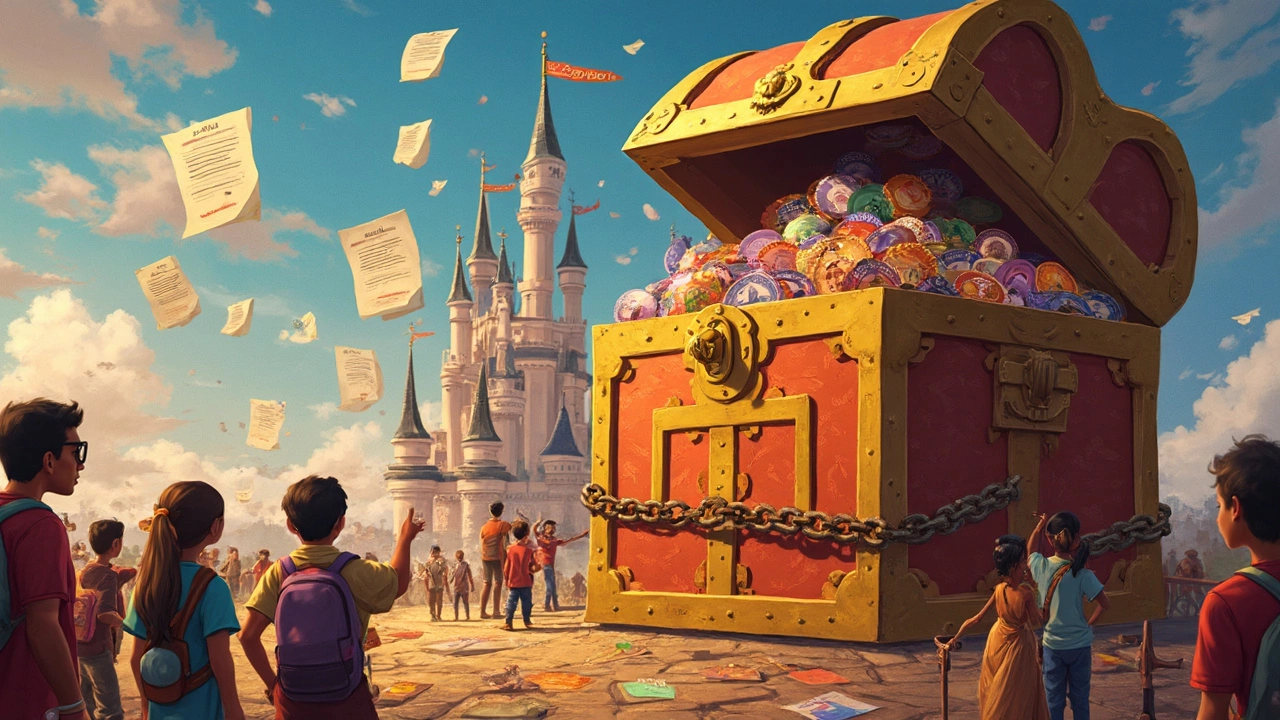
Did you know Disney owes more money than some small countries? By early 2025, Disney was carrying a debt load of around $42 billion. That's right—$42 billion, not million. The numbers are public, buried in their annual and quarterly reports, and you don't need to be an accountant to realize that's huge.
This financial weight didn't show up overnight. Most of it comes from giant moves like buying Fox in 2019, which cost Disney $71 billion up front and forced them to dig deep for cash. Add in the worldwide pandemic, expensive streaming wars, and box office flops mixed in with hits, and you've got the recipe for a pile of IOUs.
Debt isn't always bad, though. Big companies borrow all the time to fuel growth—buying studios, launching new Marvel movies, or building Star Wars lands. Still, when box office earnings take a hit (like, say, after The Marvels struggled in late 2023), the question pops up: can Disney rely on blockbusters to claw its way out of the red?
- Disney's Current Debt: The Real Numbers
- Why Did Disney Borrow So Much?
- The Box Office Impact: Are Movies Helping?
- How Disney Plans to Pay It Back
- Should Fans and Investors Worry?
Disney's Current Debt: The Real Numbers
Let's get straight to it—Disney is carrying a pretty massive amount of debt. As of their last quarterly report from March 2025, Disney lists total long-term debt right at about $42 billion. That's not pocket change. To put it in perspective, that means Disney owes more than the current GDP of some smaller countries.
Here's a simple breakdown of Disney’s recorded debt for recent years, so you can see the trend:
| Year | Total Debt ($ Billion) |
|---|---|
| 2021 | 48.1 |
| 2022 | 45.7 |
| 2023 | 43.2 |
| 2024 | 42.5 |
| Q1 2025 | ~42 |
So, the number has been dipping a little from its peak after the Fox deal, but it’s still huge. Almost all of it is long-term debt—think bonds and loans meant to be paid over many years. Recently, Disney has been refinancing some of what it owes. That means they're using new loans at (hopefully) lower interest rates to pay off older ones. It’s a common move when you’re dealing with debt on this scale.
Where does this money go? Most of Disney’s big spending comes from past deals and ongoing projects. Buying 20th Century Fox was the biggest hit, but they’ve also been putting trucks of cash into Disney+, parks, and new movie productions. They’ve got bills coming due each year, so paying interest alone is a major expense.
When you look at Disney’s financial health, analysts always weigh the debt against Disney’s ability to make money. Disney’s still making billions in revenue every quarter—parks, movies, and now streaming all matter. But the debt number is something even casual fans should keep in mind, since paying that off eats into Disney’s profits and what it can reinvest in new stuff.
Why Did Disney Borrow So Much?
When people see how much debt Disney has, they usually ask, “Why go that deep into the red?” The simple answer: Disney's ambition is massive, and it takes big money to stay at the top. Here’s what fueled the borrowing binge.
The largest chunk of debt traces straight to the 2019 buyout of most of 21st Century Fox. That deal cost a jaw-dropping $71.3 billion. Disney wanted Fox's huge movie library, control of franchises like X-Men and Avatar, and a bigger slice of international TV. To make it happen, Disney had to borrow heavily.
| Year | Disney's Total Debt (in Billions USD) | Major Financial Move |
|---|---|---|
| 2018 | ~$16 | Before Fox acquisition |
| 2019 | ~$54 | Fox acquisition |
| 2023 | ~$41 | Streamlining, pandemic impacts |
The Fox deal is only part of the story. Streaming became the new battleground. Launching Disney+ in late 2019 didn’t come cheap. Fresh tech, new shows, and global expansion made cash go out the door fast, just as box office cash flow thinned out thanks to the pandemic. Theme parks were either closed or running at half-capacity for months, so Disney had to fill budget gaps with more loans.
Here’s a quick hit list of other reasons for the big borrow:
- Disney debt helped pay for new Marvel, Pixar, and Star Wars content.
- Theme park expansions in California, Florida, and overseas—all cost billions.
- Keeping operations afloat during the COVID shutdowns needed extra funds in a hurry.
Lots of companies pile up debt to grow, but Disney went from a stable $16 billion debt in 2018 to more than triple that in less than two years. Some critics called it risky, but Disney bet big on global domination—and borrowed to back it up.

The Box Office Impact: Are Movies Helping?
When people hear about Disney’s debt, a lot immediately think, can the company’s massive box office hits fix this? It's a fair question, because Disney used to be the gold standard at the box office. Take 2019: Avengers: Endgame pulled in $2.8 billion worldwide, Frozen II cracked $1.4 billion, and The Lion King remake hit $1.6 billion. Back then, owning the theater was kind of Disney’s thing.
But here's the twist—since the pandemic, the box office hasn't exactly bounced back the way CEOs hoped. Look at a few recent numbers:
| Year | Global Box Office | Disney's Share |
|---|---|---|
| 2019 | $42B | $13B |
| 2022 | $26B | $4.9B |
| 2023 | $31B | $5.2B |
Disney’s movie revenue dropped over the last few years, even as the industry crawled back up. In 2023, films like The Marvels and Haunted Mansion sank below expectations, barely covering what it cost to make and market them. Sure, Guardians of the Galaxy Vol. 3 made a hefty $845 million, but a single hit can’t balance out a lineup of box office stumbles.
The studio has also been betting big on franchises—think Marvel and Star Wars—but there's clear fatigue showing up in ticket sales and fan reactions. My wife Priya and I noticed even our Marvel-obsessed friends started skipping new releases at the cinema and just waited for streaming.
Here's the main thing: while the box office still brings in serious money, it’s no longer the safety net it once was. Disney’s focus has shifted to streaming, and that means the movie business alone can’t erase their Disney debt fast enough. So box office hits definitely help, but they aren’t the magic cure for that $42 billion headache.
How Disney Plans to Pay It Back
Disney isn't sitting back hoping their Disney debt just vanishes. They actually have a mix of strategies lined up to handle this mountain. First off, they're banking on steady cash coming in from the parks, streaming, and movies—even if not every Marvel film is a smash hit. In 2024, Disney reported an operating cash flow of about $9.1 billion. That's a big pool for paying down those bills.
They aren’t just spending: Disney announced budget cuts, including slashing about $5.5 billion in costs last year. This meant layoffs, fewer new shows, and putting more eggs in the basket of proven movie franchises. Remember how Frozen, Toy Story, and Avengers always pop back up? That's why. These big names help keep money flowing in when original risky bets flop at the box office.
- Parks and resorts: Since the pandemic eased, park profits have bounced back. In 2024, the parks division pulled in nearly $32.5 billion in revenue. That's been their lifeline while streaming still tries to turn a real profit.
- Streaming service shake-up: Disney+ and Hulu weren't turning a profit yet, but Disney is cracking down. They're raising subscription prices and cutting unnecessary spending. Their goal: either break even or actually make some money from streaming by late 2025.
- Selling assets: When stuck, sell what you don’t need. Disney sold its stake in some TV networks and international sports assets. This brought in a few billion to help with loan payments.
Here's what the big financial picture looks like right now:
| Revenue Stream | 2024 Estimate (USD) |
|---|---|
| Theme Parks | $32.5 billion |
| Streaming (Disney+/Hulu) | $19.5 billion |
| Box Office | $5.9 billion |
| Total Debt | $42 billion |
Disney’s plan relies on balancing how much they make with how much they owe. If box office and parks stay strong, paying back those billions looks doable. But they know they can’t let streaming keep draining money forever. The next couple of years will show if this game plan holds up.

Should Fans and Investors Worry?
When you hear Disney owes $42 billion, it’s fair to wonder if the wheels are about to come off the most famous brand in entertainment. But here’s the thing: Disney isn’t your average company. Even with a huge debt, it still has tons of cash coming in from parks, movies, and streaming. In fact, Wall Street analysts often say Disney’s problem isn’t making money—it’s spending it faster than they’d like. In Q1 2025, Disney brought in over $23 billion in revenue. That’s not pocket change.
“Despite the heavy debt load, Disney’s diverse revenue streams and valuable assets make it very different from companies that might default. Investors should watch cash flow more than headline numbers.” – CNBC, April 2025
If you’re an investor, the Disney debt story boils down to three things:
- Can Disney keep earning big at the box office and through Disney+ subscriptions?
- Will theme park profits bounce back as travel gets stronger in 2025?
- Is management making smart calls to avoid blowing even more money on risky deals?
| Disney Financials (Q1 2025) | Amount |
|---|---|
| Total Debt | $42 billion |
| Quarterly Revenue | $23.7 billion |
| Theme Parks Revenue (Q1) | $7.6 billion |
| Box Office (2024 Global) | $4.3 billion |
Fans might notice fewer super-sized movie slates or theme park expansions—Disney is being a bit more careful with its projects. That’s not necessarily bad; it just means Disney is prioritizing safer bets after some costly mistakes. The company announced in late 2024 that they’re focusing on their biggest brands, and, honestly, that’s what fills theaters and parks anyway.
For now, there’s no sign that Disney’s debt will stop them from making the movies and magic everyone loves. If you’re holding Disney stock or just love binge-watching the latest Marvel series, it’s smart to pay attention—but don’t hit the panic button. Watch for steady park crowds, fresh movie releases, and growth in Disney+, since those mean Disney’s got the cash flow to pay its bills and keep the dream alive.




Write a comment